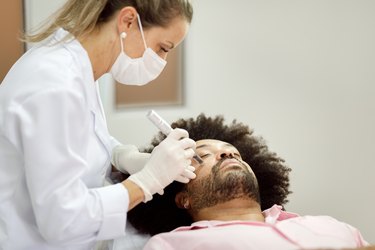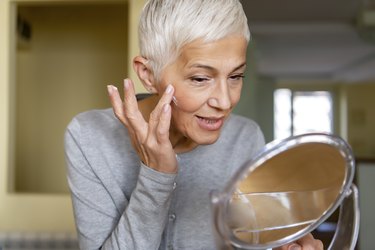
Facials are the perfect "treat yourself" self-care service that can help your skin feel refreshed and rejuvenated, whether it's a chemical peel or a simple facial massage.
But if you're looking for one that takes things a step further, a vampire facial could be for you.
Video of the Day
Video of the Day
Here, a dermatologist explains what this service entails along with the benefits and potential risks.
What Is a Vampire Facial, Exactly?
The term "vampire facial" sounds strange. What could a facial have to do with a mythical character often seen on Halloween? Well, just like a vampire draws blood with its fangs, a vampire facial involves drawing your blood with needles.
This kind of facial is more of a medical procedure than a traditional spa treatment.
"When we hear the words 'vampire facial,' what we really mean medically is microneedling," says Aanand Geria, MD, a board-certified dermatologist and founder of Geria Dermatology.
Microneedling uses thin needles to make tiny holes in the top layer of your skin, per the Cleveland Clinic. This causes your body to produce more collagen and elastin, which can help with scarring, wrinkles and fine lines.
There is a difference between classic microneedling and a vampire facial, though.
With a vampire facial, the dermatologist first extracts a small amount of your blood (usually from your arm), per the Cleveland Clinic. They spin the blood sample in a centrifuge to separate plasma and platelets, then concentrate it into something called platelet-rich plasma (PRP), which they then inject into your face via microneedling, per the American Academy of Dermatology.
That's why another term for a vampire facial is a platelet-rich plasma or PRP facial.
Both the minor damage to your skin from the microneedling and the PRP stimulate your body's wound healing response, which can lead to better skin texture and tone, per the Cleveland Clinic.
The Process
Step 1: Consultation
A vampire facial can take anywhere from 45 minutes to an hour, starting with a consultation to make sure it's a good option, Dr. Geria says. It's important to let the provider know what topical and oral medications you take, as you may need to pause some of these prior to the procedure.
Step 2: Numbing
The doctor applies a topical cream to numb your face so the procedure is more comfortable. (The numbness usually takes about a half hour to kick in and may last for a couple hours.)
Step 3: Blood Extraction
A doctor draws a small amount of blood from your arm (around 2 to 4 tablespoons), then places it in a centrifuge, a medical device that spins the blood to separate plasma and platelets. These are combined to make platelet-rich plasma, or PRP.
Step 4: Sterilization and Prep
The derm cleanses your face with alcohol, then applies the PRP to your skin.
Step 5: Microneedling Begins
The doctor guides the microneedling pen across your skin, which allows the PRP to sink in and produces some pinpoint bleeding, Dr. Geria says.
Benefits
According to the AAD, vampire facials have become a popular cosmetic treatment for benefits including:
- Fewer wrinkles
- Plumper skin
- Fewer fine lines and creases
- Improved complexion
- Faded acne scars
There have been limited studies on vampire facials, per the AAD, but the long list of potential benefits keeps the treatments in high demand.
"It yields visible results, with little to no pain or downtime," Dr. Geria says. "It is a fantastic introductory treatment for those looking for anti-aging benefits."
Tip
You can expect the results of a vampire facial to last for up to 18 months, per the AAD.
Potential Risks and Side Effects
Microneedling is generally considered a low-risk procedure with a short recovery time, which is why it's so popular. Still, Dr. Geria says, you might have some pain and swelling afterward, along with these possible side effects.
1. Post-Inflammatory Hyperpigmentation
This is when your skin forms dark spots after damage or irritation. Dr. Geria says it's more likely to happen to skin with more melanin if strict sun protection isn't followed after the procedure.
After getting a vampire facial, you should avoid sun exposure for three days and wear sunscreen and a wide-brimmed hat if you must go outdoors, Dr. Geria says.
2. Bruising
The risk of facial bruising increases especially if you're on blood thinners, like ibuprofen, Dr. Geria says. This side effect generally resolves on its own within two weeks after the vampire facial.
3. Infection
Bacterial infection is possible but rare, Dr. Geria says. This would most likely come from using unsterilized equipment during the procedure or not cleansing the face well beforehand.
Likewise, unclean equipment could put you at risk for contracting a serious disease like HIV, Dr. Geria warns.
That's why it's so important to get this treatment done only in a clean medical setting (i.e., a dermatology office or medical spa).
Who Should Not Get a PRP Facial?
According to the AAD, you should not get a vampire facial if you have any of the following conditions (which affect your platelets):
- Hepatitis C
- HIV/AIDS
- Blood cancer
- Heart disease that requires you to take a blood thinner
- Skin cancer on your face
The Bottom Line
Vampire facials can be an effective microneedling treatment to improve the overall appearance of your skin. Potential short-term benefits include fewer wrinkles and fine lines, plumper skin and reduced acne scars.
This procedure should always be done in a medical setting, such as a dermatologist's office, to minimize the risk of infection.
Is this an emergency? If you are experiencing serious medical symptoms, please see the National Library of Medicine’s list of signs you need emergency medical attention or call 911.


